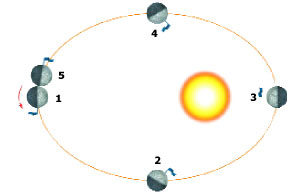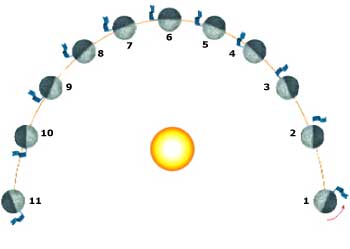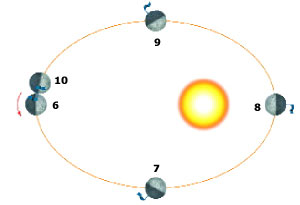|
You can experience the same process without risking an
icy fall. Simply return to that desk chair and ask a friend to spin you
around, except this time, hold your arms outstretched and grasp a heavy
object in each hand. Two phone books will do. After you're rotating at
a healthy clip, bring the books inward toward your chest. Get ready for
a dizzying whirl as your moment of inertia shrinks--and don't try to read
the books for a few minutes afterward.
Such changes in moments of inertia are critical in astronomy
because they explain why so many things in the universe spin rapidly.
When a new star forms, clumps of gas coalesce into a body that grows progressively
denser and more massive. However, the gas doesn't fall in straight lines
toward the center, since a collapsing cloud in space always starts with
some slight spin. Material drifts inward along curved paths as the cloud's
moment of inertia decreases, making it spin more quickly. After hundreds
of thousands of years, the baby star grows dense enough to ignite nuclear
fusion at its core. By that time it rotates as fast as once every day,
a breakneck pace for a ball of gas a million miles wide.
Such changes in moments of inertia are critical
in astronomy because they explain why so many things in the universe
spin rapidly.
|
Planets spin for the same reason. They form when smaller
clumps of matter congregate within the dusty disk that remains around
a new star. The disk revolves in the same direction as the star, resulting
in planets that spin in the same direction as their sun. However, there
are two exceptions in our solar system. Uranus has an axis of rotation
tilted so severely that it rolls on its side like a gaseous bowling ball.
Venus spins slowly in the opposite direction, a property called "retrograde"
spin. Fierce collisions or mergers with other large bodies early in the
solar system's history probably created these curiosities.
Even the planets with well-behaved spins aren't perfect
rotators. Earth's axis tilts 23.5 degrees from the plane of its motion
around the Sun. This leads to variations in the angle of sunlight striking
the ground, creating our cycle of seasons as the length of daylight changes.
The rotating Earth also exhibits another more subtle behavior. The axis
of a tilted rotating object wobbles in a circle if another force acts
upon it, a process called "precession." For a child's spinning top, that
force is Earth's gravity. The top wobbles slowly at first, then more quickly
as friction slows it down and brings it tumbling to the floor. For Earth
the force is the combined gravity of the Moon and the Sun. The planet's
axis takes 26,000 years to precess through one circle. Today, (continued)
|
|
All the planets in the solar system obey the physical
laws of rotation and revolution, but their individual cycles vary
widely. Mercury, for example, has been greatly affected by its nearness
to our home star. The Sun's immense gravity has exerted a strong
 tidal pull, slowing Mercury's rotation until the planet takes almost
59 Earth days to complete one full spin on its axis. This snail-like
rotation, combined with the planet's highly elliptical orbit and
the fact that its counterclockwise revolution around the Sun takes
the equivalent of only 88 Earth days, has odd consequences, as shown
here. Mercury is also unique in that its axis of rotation is not
tilted with respect to the plane of its orbit. Earth, for example,
is tilted 23.5 degrees to its orbital plane, and Uranus, with an
axial inclination of 82.1 degrees, wallows around the Sun on its
side (page 30).
tidal pull, slowing Mercury's rotation until the planet takes almost
59 Earth days to complete one full spin on its axis. This snail-like
rotation, combined with the planet's highly elliptical orbit and
the fact that its counterclockwise revolution around the Sun takes
the equivalent of only 88 Earth days, has odd consequences, as shown
here. Mercury is also unique in that its axis of rotation is not
tilted with respect to the plane of its orbit. Earth, for example,
is tilted 23.5 degrees to its orbital plane, and Uranus, with an
axial inclination of 82.1 degrees, wallows around the Sun on its
side (page 30).
|
 |
Watching the Sun Rise--Twice
An observer on Mercury who has watched the sun
rise once (below, 2) is pulled back into darkness (6)
when the planet is at perihelion, its closest approach to the Sun.
The Sun's gravitational pull causes Mercury's orbital speed to exceed
its slow rate of axial rotation. Once the planet is past perihelion,
the Sun pulls on Mercury from behind, slowing its orbital speed.
The observer travels back across the daynight line to see
the sun rise again (10 and above). 
|
 |
| A Long (Two-Year) Day
Because of its 59-Earth-day rotation and 88-day orbital
period, Mercury's days last two years (above). If an observer (flag)
sees the Sun come up when Mercury is at aphelion, farthest from the Sun
(1), noon occurs at perihelion (3). Sunset (5), at
the next aphelion, ends one year and begins the next (6). Midnight
occurs at the next perihelion (>8). Dawn (10) begins year
three. |
|

